8 March 2017
It baffles me to observe a piece of chocolate being popped into one’s mouth, only to be instantly ground to smithereens. Hold on! How can chocolate be truly and thoroughly enjoyed if it’s just being chewed and swallowed? On this point, have you considered exactly what it is that attracts you to chocolate? Is it the aesthetics of the fancy packaging or glossy temper? The silky smooth texture? Perhaps the enticing aroma and sweet taste or a combination thereof?
If you’ve ever wanted to delve deeper to discover the root of your chocolate passion or obsession, the best place to start is by deriving complete enjoyment from every mouthful. While I’m by no means an expert in chocolate appreciation, here are some tips and lessons that I’ve picked up along my chocolate adventures.
Take Your Time
The act of consuming chocolate is not a competition or race. Pause, be in the moment and take the time to savour every mouthful.
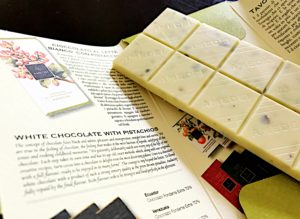 If available, make the effort to read the label or packaging to understand what it is you’re consuming, the ingredients that have gone into its production and the economic, social and environmental impact of the chocolate.
If available, make the effort to read the label or packaging to understand what it is you’re consuming, the ingredients that have gone into its production and the economic, social and environmental impact of the chocolate.
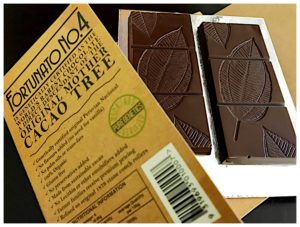 It’s also worth understanding the story of the cacao beans including the variety, region, country of origin, terroir and method of processing. If you’re a chocolate nerd like me, this will be enough to get you excited even before your first mouthful!
It’s also worth understanding the story of the cacao beans including the variety, region, country of origin, terroir and method of processing. If you’re a chocolate nerd like me, this will be enough to get you excited even before your first mouthful!
Connect With Your Senses
See, smell, hear, touch and taste the chocolate. Use all your senses to experience it.
See the Chocolate
Starting with your eyes, observe the colour. Is it dark brown, red brown, white or almost black?
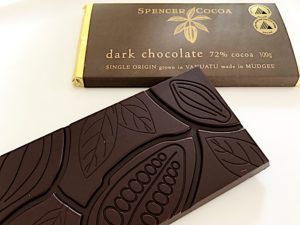 Look at the surface. Does it have a shiny, glossy sheen or looks dull with whitish or light brown spots? A shiny, glossy sheen is an indication of well tempered chocolate. Conversely, a dull surface with spots is likely to indicate bloom, either sugar bloom (sugar dissolves in moisture from condensation and crystallises upon its evaporation) or fat bloom (fat in the form of cocoa butter crystals deposit on the surface of the chocolate). Both are usually caused by suboptimal chocolate storage conditions and in the case of fat bloom, inadequate tempering. The chocolate is still nonetheless edible but obviously, this affects the overall experience. And on this note, an invaluable piece of advice to always bear in mind – avoid storing your chocolates in the fridge! The optimum storage temperature of chocolate is between 15 to 18 degrees Celsius.
Look at the surface. Does it have a shiny, glossy sheen or looks dull with whitish or light brown spots? A shiny, glossy sheen is an indication of well tempered chocolate. Conversely, a dull surface with spots is likely to indicate bloom, either sugar bloom (sugar dissolves in moisture from condensation and crystallises upon its evaporation) or fat bloom (fat in the form of cocoa butter crystals deposit on the surface of the chocolate). Both are usually caused by suboptimal chocolate storage conditions and in the case of fat bloom, inadequate tempering. The chocolate is still nonetheless edible but obviously, this affects the overall experience. And on this note, an invaluable piece of advice to always bear in mind – avoid storing your chocolates in the fridge! The optimum storage temperature of chocolate is between 15 to 18 degrees Celsius.
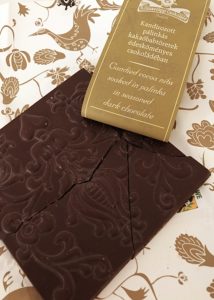 Admire the artistry of the colours, shapes and designs of the chocolate moulds. The latter can be both unique and beautiful, and provide a glimpse into the personality, heritage or background of the chocolate maker. Take for example the chocolate bars from Hungarian bean to bar maker Rózsavölgyi Csokoládé that are moulded to look like 19th Century Hungarian fire place tiles.
Admire the artistry of the colours, shapes and designs of the chocolate moulds. The latter can be both unique and beautiful, and provide a glimpse into the personality, heritage or background of the chocolate maker. Take for example the chocolate bars from Hungarian bean to bar maker Rózsavölgyi Csokoládé that are moulded to look like 19th Century Hungarian fire place tiles.
Smell the Chocolate
Put the piece of chocolate to your nose, like you would do with a glass of wine, and inhale deeply. Cup your hands around the chocolate and repeat a few times. What do you smell? Is it intense or faint?
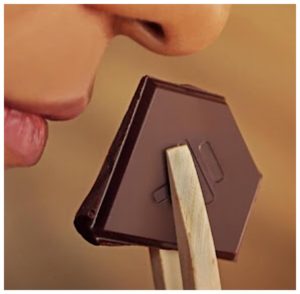
Try to associate the smells or aromas with common external stimuli like earth/ soil, trees, herbs, flowers and smoke to common foods like fruits, nuts, mushrooms, and sugar derived treats like caramel and toffee. It’s of course easier to do this with plain chocolates. The sensitivity and breadth of our sense of smell differs from individual to individual, so don’t worry if you smell something completely different to the next person.
Hear the Chocolate
For chocolate bars or squares, break a piece off. Does the chocolate break off with a short, sharp snap?
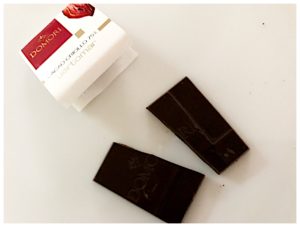
For bite-sized chocolates like pralines, ganaches and truffles, take a bite. Do you hear a short, sharp snap as you sink your teeth into it?
You should be able to hear the characteristic snap in well tempered chocolate.
Touch the Chocolate
Hold the piece of chocolate between your thumb and forefinger. Rub it and as it contacts the warmth of your fingers, it should start to melt. Is the texture smooth, gritty or uneven? Well conched chocolate should feel silky smooth to touch.

Place a bite-sized piece on your tongue and let it melt. Rub it between your tongue and the top of your palate. As the chocolate melts, does it have a smooth and even mouthfeel or gritty, lumpy texture? Well conched chocolate should have a very smooth and even mouthfeel. However, it’s normal for unconched, stone ground chocolate to be gritty, with an uneven texture.
Taste the Chocolate
Now, inhale deeply and as you exhale, begin to taste the chocolate. Is it sweet, sour/ acidic, bitter, astringent/ tannic or umami?
What flavours do you detect? Are they intense or faint? Are they similar to the aromas you’ve identified such as earthy, spicy, floral, smokey, fruity, nutty, caramel or toffee like, or completely different? For pralines, ganaches and truffles, can you taste the intended flavours?
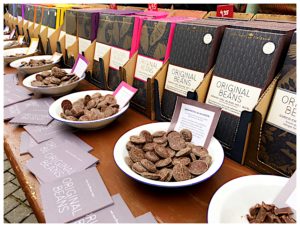 Are the flavours fleeting or do they build up and linger? Is the flavour profile flat or multi-dimensional and changes with time? It’s not unusual for the flavour profile of single origin and blended good quality chocolate to vary as the chocolate melts. The same holds true for “layered” pralines, ganaches and truffles.
Are the flavours fleeting or do they build up and linger? Is the flavour profile flat or multi-dimensional and changes with time? It’s not unusual for the flavour profile of single origin and blended good quality chocolate to vary as the chocolate melts. The same holds true for “layered” pralines, ganaches and truffles.
When all the chocolate has melted, does it leave an aftertaste in your mouth? Good quality chocolate should leave a clean finish with minimal aftertaste.
Bringing It All Together
When you consume your next mouthful of chocolate, give these basic chocolate appreciation tips a go.
Pause and get to know the chocolate you’re eating.
See, smell, hear, touch and taste it.
Once you’ve experienced the chocolate in its entirety, reflect on the outcome and revisit the question – what do you love about chocolate? You may be pleasantly surprised by what you discover!
 Our first stop is the hip suburb of East Brunswick, to unmask the secrets behind the red door that is
Our first stop is the hip suburb of East Brunswick, to unmask the secrets behind the red door that is 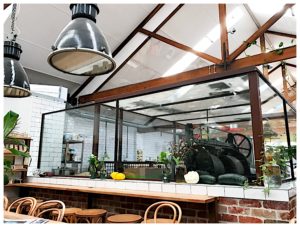
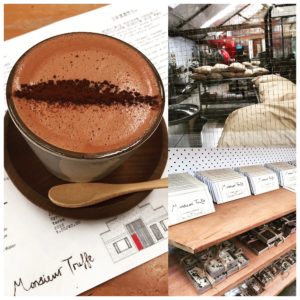 I’d recommend the 80% dark single origin Dominican Republic hot chocolate for the connoisseurs out there, enjoyed with a single origin bar like the limited edition Samoan 67% cacao.
I’d recommend the 80% dark single origin Dominican Republic hot chocolate for the connoisseurs out there, enjoyed with a single origin bar like the limited edition Samoan 67% cacao. Next up, we go in search of a hidden gem amongst the many fruit, vegetable, poultry, meat and flowers stalls, in the Prahran markets.
Next up, we go in search of a hidden gem amongst the many fruit, vegetable, poultry, meat and flowers stalls, in the Prahran markets.  Tad, its owner and chocolatier, has developed a loyal following of his handcrafted ganaches, pralines, rochers and truffles, made in the minute on-site kitchen using Felchin Swiss couverture chocolate. The chocolate sourdough bar, with inclusions of crisp sourdough bread and available in milk and dark, is also a crowd pleaser. There’s sadly a no photo policy within the shop so I can’t share the extent of the chocolate range here.
Tad, its owner and chocolatier, has developed a loyal following of his handcrafted ganaches, pralines, rochers and truffles, made in the minute on-site kitchen using Felchin Swiss couverture chocolate. The chocolate sourdough bar, with inclusions of crisp sourdough bread and available in milk and dark, is also a crowd pleaser. There’s sadly a no photo policy within the shop so I can’t share the extent of the chocolate range here.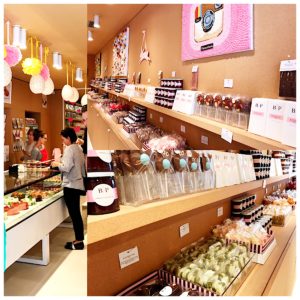 Our next destination is best described as a modern day Hansel and Gretel candy “house”. At
Our next destination is best described as a modern day Hansel and Gretel candy “house”. At 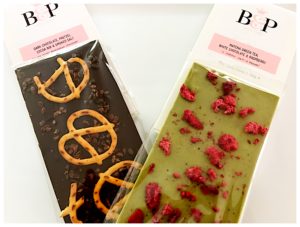 If you’re here for chocolate, although it’s easy to be swayed by the tantilising array of other sweet offerings, check out the vibrant bars like matcha green tea in white chocolate with raspberries, explosive raspberry popping candy in white chocolate and single origin 66% Madagascan dark chocolate flavoured with tonka bean and pieces of dried pineapple and banana chips.
If you’re here for chocolate, although it’s easy to be swayed by the tantilising array of other sweet offerings, check out the vibrant bars like matcha green tea in white chocolate with raspberries, explosive raspberry popping candy in white chocolate and single origin 66% Madagascan dark chocolate flavoured with tonka bean and pieces of dried pineapple and banana chips. There’s no mistaking the purpose of our visit to
There’s no mistaking the purpose of our visit to 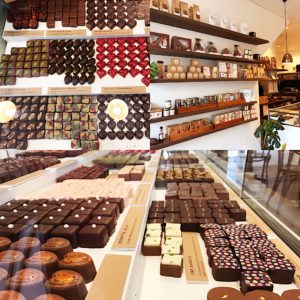 The most difficult decisions that one has to make are simply which flavours and how many to purchase. They all look equally as tasty with inventive flavour combinations like botrytis jelly, cardamon, mascarpone and raspberry, basil and champagne, and olive oil and sea salt.
The most difficult decisions that one has to make are simply which flavours and how many to purchase. They all look equally as tasty with inventive flavour combinations like botrytis jelly, cardamon, mascarpone and raspberry, basil and champagne, and olive oil and sea salt.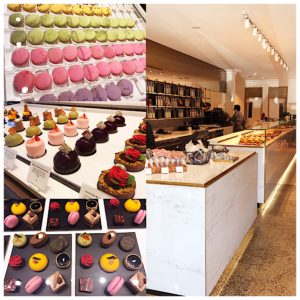 It’s over to South Melbourne next to feast my eyes on jewel-like sweet creations.
It’s over to South Melbourne next to feast my eyes on jewel-like sweet creations. 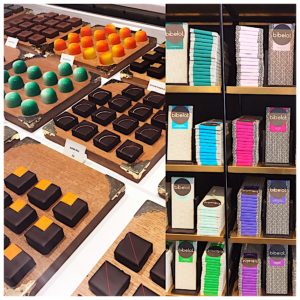 The chocolate creations here extend to tablettes or bars in white, milk or dark, bite sized chocolate treats, chocolate fudge and house-made gelato ready to be drizzled with dark or milk chocolate from the perpetually running chocolate taps. A true haven for the chocoholic.
The chocolate creations here extend to tablettes or bars in white, milk or dark, bite sized chocolate treats, chocolate fudge and house-made gelato ready to be drizzled with dark or milk chocolate from the perpetually running chocolate taps. A true haven for the chocoholic.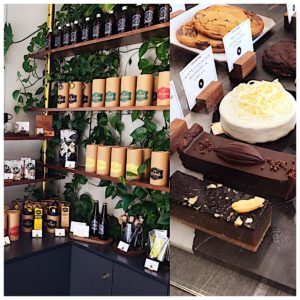 The last stop that we manage to fit in, in this “Race” against time, is a purveyor of artisan hot chocolate. Located in North Melbourne,
The last stop that we manage to fit in, in this “Race” against time, is a purveyor of artisan hot chocolate. Located in North Melbourne,  There’s even a house-made cocoa flavoured soft drink. The Cacao Cold Brew is both light and freshening. Plus, the young at heart chocolate connoisseurs may be interest to hear about the new limited release 60% dark chocolate milk, a twist on the childhood treat with a touch of decadence.
There’s even a house-made cocoa flavoured soft drink. The Cacao Cold Brew is both light and freshening. Plus, the young at heart chocolate connoisseurs may be interest to hear about the new limited release 60% dark chocolate milk, a twist on the childhood treat with a touch of decadence.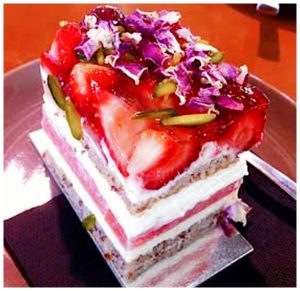
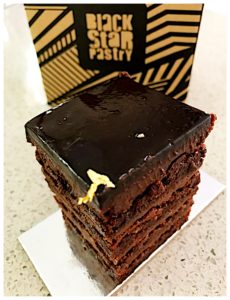




 The brainchild of its namesake creator,
The brainchild of its namesake creator, 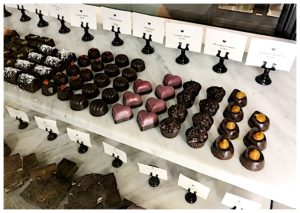 At this point, some of you may be wondering – is it free of flavour too? I had my doubts so decided to pay a visit to the single Sydney store, located in the industrial-turned-hip suburb of Alexandria. In hindsight, perhaps I could have picked a better day – extreme summer conditions with the mercury hovering around the high 30s to low 40s degrees Celsius and a malfunctioning freezer. Nonetheless, I persist. It’s quiet when I arrive. There’s the familiar sight of the signature raw chocolate bars. On top of this, there’s also a tantalising selection of raw chocolate cake slices, ganaches, pralines, rochers and chocolate squares. It’s too early for cake so I settle on a small selection of ganaches, in particular the Caramel Lava Drop, Turkish Rose, Coconut Barrel and Lavender Heart.
At this point, some of you may be wondering – is it free of flavour too? I had my doubts so decided to pay a visit to the single Sydney store, located in the industrial-turned-hip suburb of Alexandria. In hindsight, perhaps I could have picked a better day – extreme summer conditions with the mercury hovering around the high 30s to low 40s degrees Celsius and a malfunctioning freezer. Nonetheless, I persist. It’s quiet when I arrive. There’s the familiar sight of the signature raw chocolate bars. On top of this, there’s also a tantalising selection of raw chocolate cake slices, ganaches, pralines, rochers and chocolate squares. It’s too early for cake so I settle on a small selection of ganaches, in particular the Caramel Lava Drop, Turkish Rose, Coconut Barrel and Lavender Heart.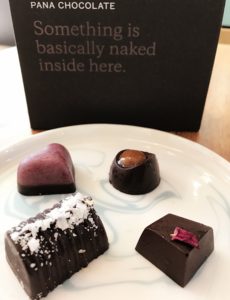 I’m truly amazed by how good they taste! Thumbs up for the Coconut Barrel – a generous centre of dessicated coconut, enrobed in dark raw chocolate. The savouriness of the coconut pairs very well with the dark chocolate, and balances the overall sweetness. The Turkish Rose, far from Pana’s take on the Turkish delight, is in fact pure essential rose oil infused raw chocolate ganache. It’s pleasant on the palate, with just the right amount of sweetness. The Lavender Heart, a perfect Valentine’s Day treat for a loved one, comprises a layer of lavender infused white chocolate, sitting atop dark raw chocolate. It’s rich, smooth, has accents of lavender, a hint of salt and subtle sweetness that just pulls the whole combination together beautifully. The Caramel Lava Drop is dark raw chocolate with a dollop of molten caramel – I like the ooziness of the caramel but this combination is a tad sweet for me.
I’m truly amazed by how good they taste! Thumbs up for the Coconut Barrel – a generous centre of dessicated coconut, enrobed in dark raw chocolate. The savouriness of the coconut pairs very well with the dark chocolate, and balances the overall sweetness. The Turkish Rose, far from Pana’s take on the Turkish delight, is in fact pure essential rose oil infused raw chocolate ganache. It’s pleasant on the palate, with just the right amount of sweetness. The Lavender Heart, a perfect Valentine’s Day treat for a loved one, comprises a layer of lavender infused white chocolate, sitting atop dark raw chocolate. It’s rich, smooth, has accents of lavender, a hint of salt and subtle sweetness that just pulls the whole combination together beautifully. The Caramel Lava Drop is dark raw chocolate with a dollop of molten caramel – I like the ooziness of the caramel but this combination is a tad sweet for me.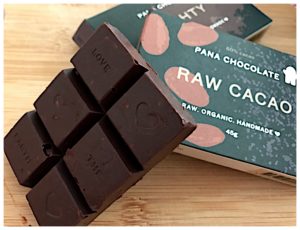 I’ve also tried several of
I’ve also tried several of 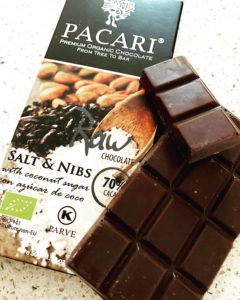 I can’t get enough of the Raw 70% Salt and Nibs bar. The cacao nibs and sea salt granules are a play on textures in this rich and smooth bar, sweetened with coconut sugar.
I can’t get enough of the Raw 70% Salt and Nibs bar. The cacao nibs and sea salt granules are a play on textures in this rich and smooth bar, sweetened with coconut sugar.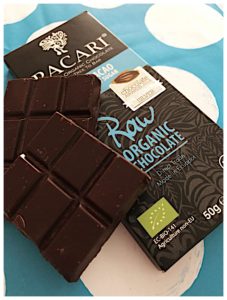 The Raw 85% bar is intensely earthy, both in aroma and flavour. It’s also slightly bitter, mildly acidic and with a lengthy finish of lemons, skins and all. Strongly recommended for the cacao enthusiast.
The Raw 85% bar is intensely earthy, both in aroma and flavour. It’s also slightly bitter, mildly acidic and with a lengthy finish of lemons, skins and all. Strongly recommended for the cacao enthusiast.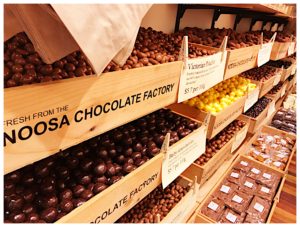
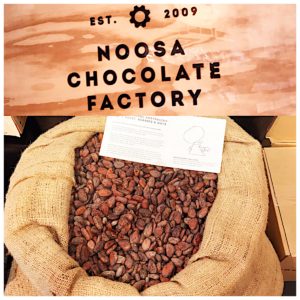 The chocolate is made bean to bar from cacao beans sourced directly from farmers in Papua New Guinea and available as 77% dark, 40% milk and 37% white cacao chocolate. The added attraction is the freshness of the chocolates – apparently “made from scratch in the last 72 hours” in their factory in Noosa. My top seasonal picks are the chocolate baby strawberries (they’re actually not that small!), chocolate cherries and the Bowen mango macadamia.
The chocolate is made bean to bar from cacao beans sourced directly from farmers in Papua New Guinea and available as 77% dark, 40% milk and 37% white cacao chocolate. The added attraction is the freshness of the chocolates – apparently “made from scratch in the last 72 hours” in their factory in Noosa. My top seasonal picks are the chocolate baby strawberries (they’re actually not that small!), chocolate cherries and the Bowen mango macadamia.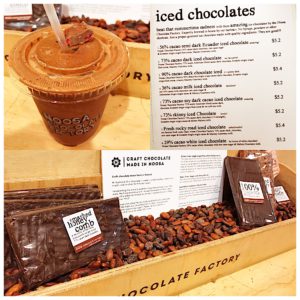 If you drop by their cafe and retail outlet, “The Dark Chocolatier”, just five doors down from their flagship store, do try their hot or iced chocolates. I had the 73% dark cacao skinny iced chocolate and it was delish!
If you drop by their cafe and retail outlet, “The Dark Chocolatier”, just five doors down from their flagship store, do try their hot or iced chocolates. I had the 73% dark cacao skinny iced chocolate and it was delish!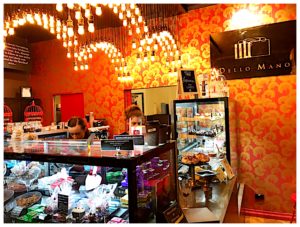 Brownies are brownies…..until you sink your teeth into
Brownies are brownies…..until you sink your teeth into 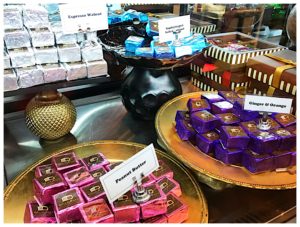 Phoebe, the owner’s daughter, tells me that the Luxury Classic is the original flavour and their most popular, and offers me a sample. It’s decadent, rich, chocolatey and very moorish. I can definitely appreciate its appeal and end up with several brownies to take home with me, based on Phoebe’s recommendation. Aside from the brownies,
Phoebe, the owner’s daughter, tells me that the Luxury Classic is the original flavour and their most popular, and offers me a sample. It’s decadent, rich, chocolatey and very moorish. I can definitely appreciate its appeal and end up with several brownies to take home with me, based on Phoebe’s recommendation. Aside from the brownies, 
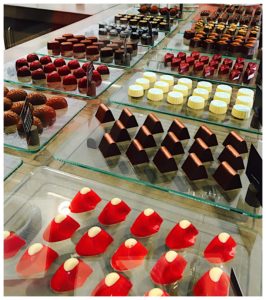 Murielle takes inspiration from several sources in creating her flavours, including her Swiss heritage (The Matterhorn) and suggestions/ requests by her regular clientele (Alexandria’s Mint).
Murielle takes inspiration from several sources in creating her flavours, including her Swiss heritage (The Matterhorn) and suggestions/ requests by her regular clientele (Alexandria’s Mint).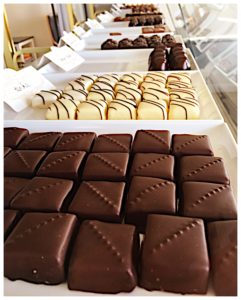 Another destination worthy of a mention is
Another destination worthy of a mention is